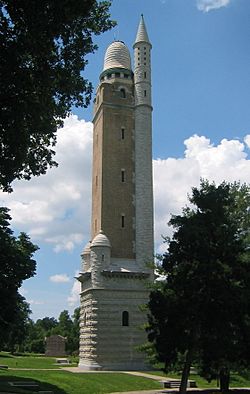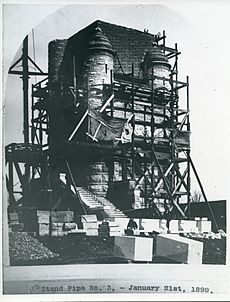Compton Hill Reservoir Park facts for kids
Quick facts for kids Compton Hill Reservoir Park |
|
|---|---|

Compton Hill Water Tower, one of only seven surviving standpipe water towers in the United States, is a national historic landmark.
|
|
| Type | Municipal |
| Location | St. Louis, Missouri |
| Area | 35.8 acres (14.5 ha) |
| Created | 1867 |
| Operated by | City of St. Louis |
| Open | All year |
|
Compton Hill Water Tower
|
|
| Location | St. Louis, Missouri |
| Built | 1898 |
| Architect | Harvey Ellis |
| Architectural style | French Romanesque |
| NRHP reference No. | 72001555 |
| Added to NRHP | September 29, 1972 |
Compton Hill Reservoir Park is a 36-acre (15 ha) public park located in the Compton Heights neighborhood of St. Louis, Missouri, USA. Located on one of the highest elevations within the city, the park surrounds a 28-million-US-gallon (110,000 m3) reservoir used to provide water for many of the city's residents.
History
James P. Kirkwood selected the site of the reservoir, one of the highest elevations within the 1855 city limits. As the reservoir occupied only 18 acres (7.3 ha) of the site, Kirkwood suggested the remaining land be turned into a park. The top of the reservoir structure was at one time covered with elevated tennis courts; presently, two newer tennis courts lie to the east.
The water tower was retired in 1929, after 30 years, when the Howard Bend Plant was put in service: the static head from the Stacy Park Reservoir, in what is now the St. Louis suburb of Olivette, caused an overflow of pure chemically treated water into the sewer system. The reservoir and water tower were renovated, in 1999, at a cost of $19 million.
In 1969, Interstate 44 was constructed through the northern edge of the park, reducing the area of the park to its present size.
Compton Hill Water Tower
The Compton Hill Water Tower, built in 1898, is the youngest of three remaining stand pipe-water towers in St. Louis. Whereas, in 1901, more than 423 stand pipe style water towers existed in the United States, as of 2008 only about a dozen remain standing, three of which are in St. Louis (the other two being the Bissell Tower and the Grand Avenue Water Tower). The 179-foot (55 m) tower was built to disguise a 6-foot (1.8 m) diameter, 130-foot (40 m) tall standpipe in its interior. The standpipe helped to control the dangerous surges in the city's pipes caused by the reciprocating pumps and maintain an even water pressure. The water tower was designed by Harvey Ellis who also had a hand in designing the headhouse for St. Louis Union Station. Occasionally, the observation deck at the top of the water tower is opened to the public, allowing visitors to see 360-degree panoramic views of the city. The Compton Hill Water Tower was declared a city landmark in 1966 and added to the National Register of Historic Places in 1972.


